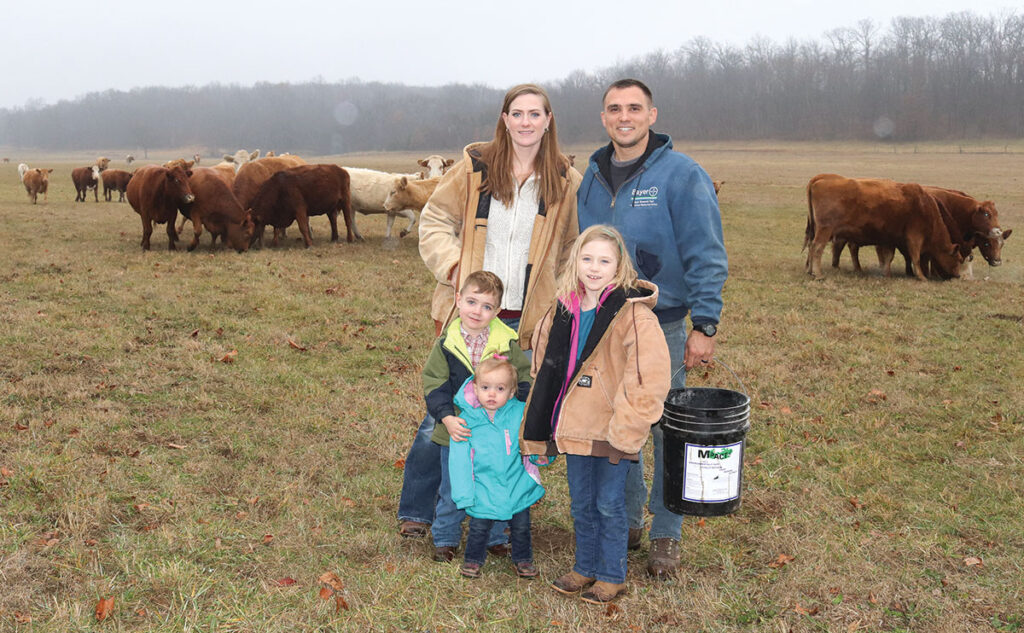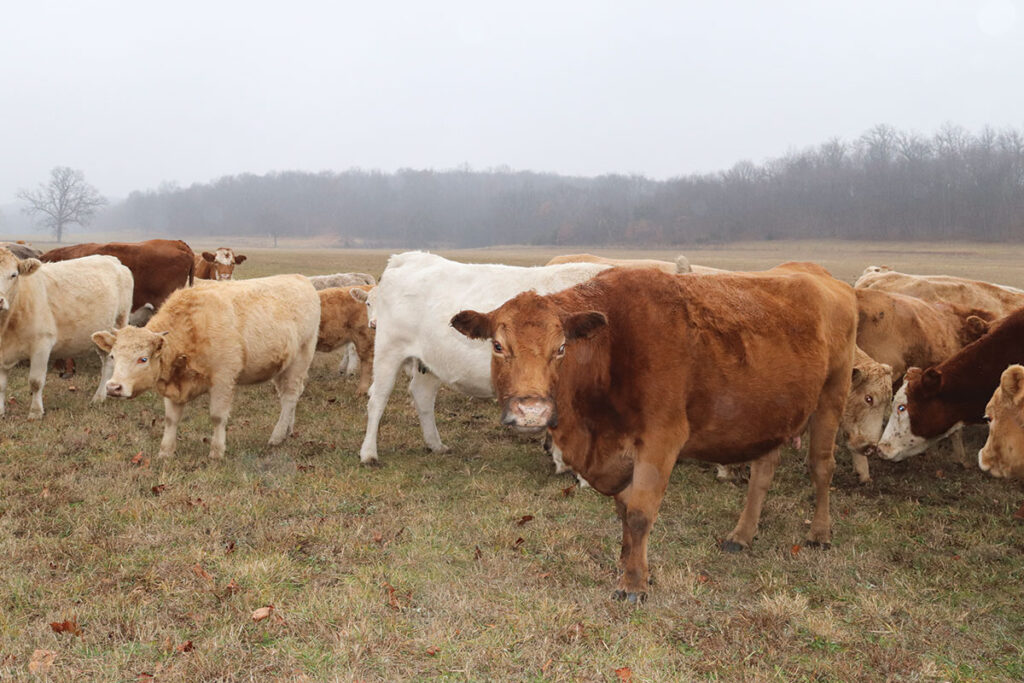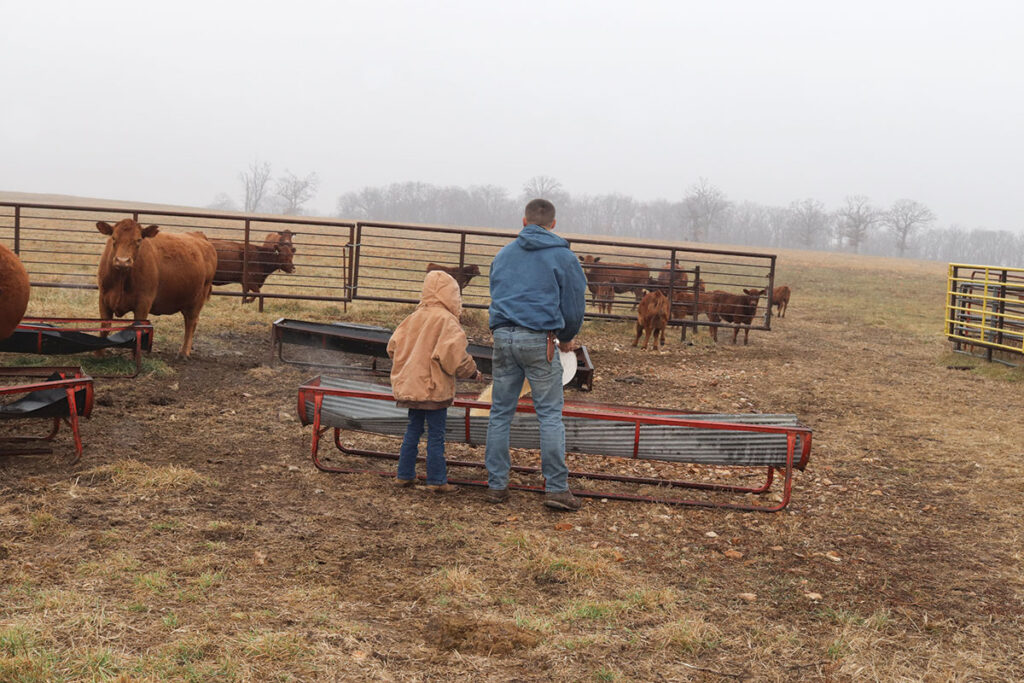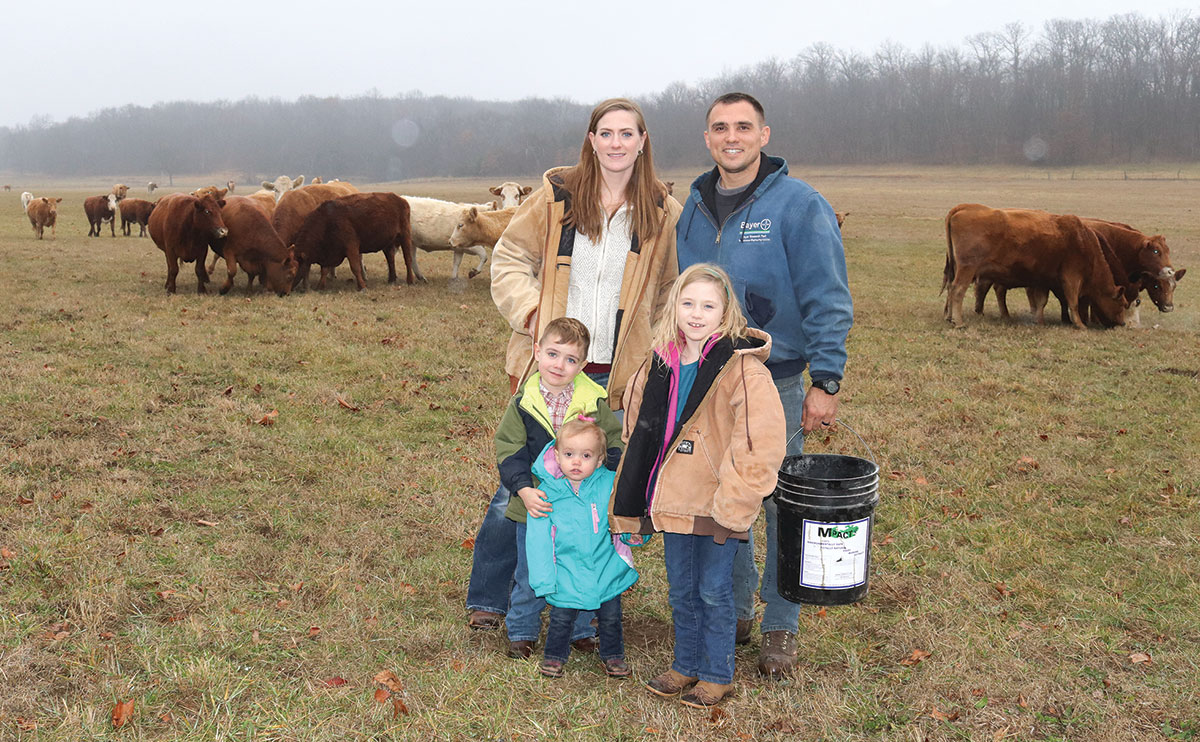
Dan and Shelby Wisner have a diversified livestock and crop operation
OSCEOLA, MO. – In college, Dan Wisner said his professors stressed specialized production. That, however, wasn’t what the seventh-generation farmer from Osceola, Mo., had in mind.
“I think diversity is a problem solver,” Dan said. “I love diversity because you never get bored. I get tired of driving a tractor back and forth, and back and forth. With diversity, there’s something new every day. We also want to keep our kids involved. One might despise going out and plowing a field but love working with animals. You also can’t get ahead by doing what everyone else is doing. Diversity spreads your risk, and that’s what my grandpa Juanita [Wisner] always preached; don’t put your eggs all in one basket.”
The Wisners’ main operation is 150-head cow/calf herd, but the family also has row cows, meat goats, a small farm-to-plate pork operation, and a recently acquired haired sheep flock.
Dan and his wife Shelby own 300 acres and are part of family operations that take in another 400 acres.
The Wisner cattle are a commercial operation, with herds with Angus and Charolais influences. Additionally, a red Beefmaster bull and Limousin have become part of the breeding program.
“We’re a cow of every color,” Dan said. “My granddad, Bill Malloy, he’s always been a Charolais man, so I’m carrying on with those genetics. Then on the other side, the Wisner side, they have always been Angus, so I can’t argue either way.”
Bulls remain with the herds, which allows the Wisners to have calves at various times to market.
“I don’t mind calving out in the summer,” Dan said. “Because we’re always moving to fresh grass, we don’t have to worry about the dust.”
Calves are sold at about 750 pounds, with some heifers retained for future development. Dan said they also buy a few heifers each year. Retained females and those purchased do not go into the breeding program until they are about 18 months old, giving the future cows additional time to grow before growing a calf.
“As some elder farmers retire, I try to buy out their seedstock,” he said. “That’s how I picked up some good Limousins.”
The breed of cattle is not as important to Dan and Shelby as the quality and each animal’s ability to be productive. They prefer cattle that require few inputs to maintain condition and raise quality calves.

“They need to survive on good grass, good hay and mineral,” Dan said.
Calves stay with their dams until they are about 7 months old. Dan said the cows began the natural weaning process by that age, so weaning tends to be less stressful. They also utilize fenceline weaning to reduce stress.
Calves are then offered grain 30 to 60 days prior to being sold. Bulls are castrated at about 600 pounds to allow for additional growth.
Dan, a loan officer at St. Clair County State Bank, did draw from his college days to make their cattle operation work with fewer inputs.
“I’m a big fan of rotational grazing; it was one of those wild ideas I picked up at college,” Dan said, adding he also attended a grazing school but modified the practices to suit his farm and farming methodology. “I would love to do some mob grazing if time would allow it. We see such huge benefits with [rotational grazing]. Rotational grazing has also helped in the handling of the cattle; I can take them anywhere. We cross paved roads, gravel roads, we lead them for 40 acres of brush because they are looking for that fresh grass.”
Shelby added the ease of handling allows their children (7-year-old Lydia, 4-year-old Truman and 1-year-old Lila) to be a part of the farming operation.
Moving cattle frequently also reduces parasites and aids in fly control because the lifecycle is broken.
“We haven’t had to worm for as long as I can remember. I don’t run my cows through the chute unless I have to. I will give calves a blackleg and tetanus; other than that, I don’t worry about vaccinations. We want our cattle to be calm and docile around the kids, so not stressing them out helps keep them calmer,” Dan said.
The family produces the hay needed for their herd, all while having stockpiled forages.
“All of my cows have access to grass, and grass ahead of them, but they get a little hay to save that grass better days. Until this year, we were averaging 2.5 to 2.7 bales per cow in the winter,” Dan said. “My grandpa tends to hay a little more than I do; I like to stockpile a little more. “We do the best we can with our pastures and keep improving.”
They typically broadcast clovers and lespedeza in March to help replenish forages.

Because of their rotational system, Dan said forages quickly rebounded after some much-needed rain in the fall. They are adding paddocks as they can to the system, but where the paddocks are located and how big they are depends on existing pasture infrastructures, such as water supplies and fencing.
To make further use of pastures, Dan has incorporated milo.
“I’ve had some success, but timing is everything,” he said. “I can graze a pasture, then no-till it in June, and if the rains are right, you have the cool season grasses going dormant, and the sorghum is coming on. I have harvested some grain from my pastures.”
Part of the future changes to the rotational system includes following the cattle with the goats and sheep. They currently have Kiko/Spanish goats with some Boer influence. The sheep are the newest edition, with a small flock of Katahdins.
“The ragweed is going to waste out there, might as well have sheep out eating them,” Dan said. “With the goats, they will eat everything they can reach; they will eat locust sprouts, weeds, thistles. We are all about trying to make things efficient. We try not to waste a blade of grass or an ounce of sunshine.”
There are some drawbacks to sheep and goat production.
“If water will go through a fence, they can too,” Dan said. “That one strand of wire works great for the cows; it’s pop and go, but not for the goats.”
Goat kids are sold at area livestock markets, providing another income stream.
Their four-sow hog operation allows the entire family to have farm-raised pork and the opportunity to sell as few pigs to others. They farrow once a year, and the pigs are part of a shared operation with Dan’s parents, Curtis and Cindy Wisner, in nearby Vista, Mo., which is also where the sheep and goats are housed.
“When we butcher the pigs, it gets the whole family involved,” Shelby said. “It’s a multi-generational thing when we do that.”
The family’s cropping operation produces portion of the feed required for their livestock.
“We have milo and corn grown here on the farm,” Dan said. “We have to buy our soybean meal to add for protein and energy, and I mix it here for the pigs and the cattle.”
Dan said the family grows corn, wheat, oats and soybeans.
“We’re trying to get into more oats,” Dan said. “I should have a good oat crop, even if I don’t get any other crops if we go into a drought year. We do a lot of double cropping and try to do a lot of no-till. We also try a few cover crops as time allows, mostly crimson clover and rye. Ideally, with more fences, we will also be able to graze that. If I can graze off a field, plant milo, harvest the milo, then graze the cool grasses in the fall, that just doubles my income.”
In addition to feeding their livestock, the Wisner family markets a portion of their crops.
“It’s all part of maximizing efficiency,” Dan said. “When you have limited resources, and we all know what the price is for land, you have to be efficient in what you do. You are also helping the soil by diversifying. We try not to do beans, on beans, on beans.”
Additionally, soil fertility is monitored closely in all fields and pastures.
“We try to add as needed,” Dan said. “I really like using chicken litter, which can get hard to come by.”
As the family grows, so do their goals. Dan and Shelby hope to add a processing facility for beef and pork, and a mobile poultry coop with a capacity to house 5,000 birds.
Dan hopes his children will be as eager to be the next generation as he was.
“I have to give credit to my dad,” Dan said. “Everywhere he went, I went, no matter what kind of a farm job it was. He’s a full-time farmer, and I guess I’m the first one who hasn’t been a full-time farmer. Dad is where I got my love for it. I hope my kids find that passion like I did.”
Shelby, a nurse at Golden Valley Medical-Osceola and who Dan refers to as their resident veterinarian, is sure their young children will also find the passion.
“Truman will follow him anywhere,” she said.
“Lydia will be our animal person,” Dan said.







